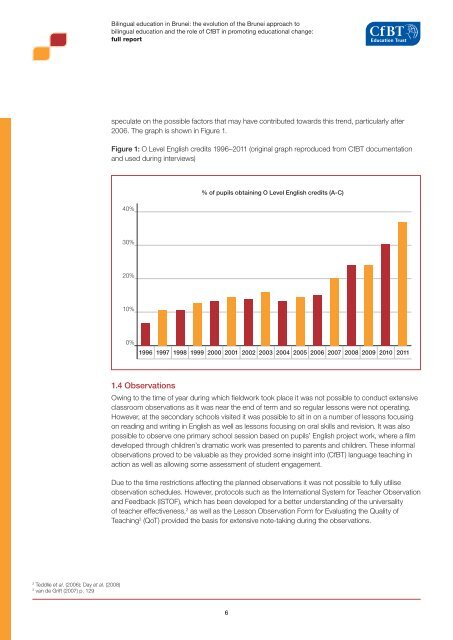r-brunei-full-2014
r-brunei-full-2014
r-brunei-full-2014
You also want an ePaper? Increase the reach of your titles
YUMPU automatically turns print PDFs into web optimized ePapers that Google loves.
Bilingual education in Brunei: the evolution of the Brunei approach to<br />
bilingual education and the role of CfBT in promoting educational change:<br />
<strong>full</strong> report<br />
speculate on the possible factors that may have contributed towards this trend, particularly after<br />
2006. The graph is shown in Figure 1.<br />
Figure 1: O Level English credits 1996–2011 (original graph reproduced from CfBT documentation<br />
and used during interviews)<br />
40%<br />
% of pupils obtaining O Level English credits (A-C)<br />
30%<br />
20%<br />
10%<br />
0%<br />
1996 1997 1998 1999 2000 2001 2002 2003 2004 2005 2006 2007 2008 2009 2010 2011<br />
1.4 Observations<br />
Owing to the time of year during which fieldwork took place it was not possible to conduct extensive<br />
classroom observations as it was near the end of term and so regular lessons were not operating.<br />
However, at the secondary schools visited it was possible to sit in on a number of lessons focusing<br />
on reading and writing in English as well as lessons focusing on oral skills and revision. It was also<br />
possible to observe one primary school session based on pupils’ English project work, where a film<br />
developed through children’s dramatic work was presented to parents and children. These informal<br />
observations proved to be valuable as they provided some insight into (CfBT) language teaching in<br />
action as well as allowing some assessment of student engagement.<br />
Due to the time restrictions affecting the planned observations it was not possible to <strong>full</strong>y utilise<br />
observation schedules. However, protocols such as the International System for Teacher Observation<br />
and Feedback (ISTOF), which has been developed for a better understanding of the universality<br />
of teacher effectiveness, 2 as well as the Lesson Observation Form for Evaluating the Quality of<br />
Teaching 3 (QoT) provided the basis for extensive note-taking during the observations.<br />
2<br />
Teddlie et al. (2006); Day et al. (2008)<br />
3<br />
van de Grift (2007) p. 129<br />
6


